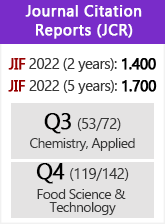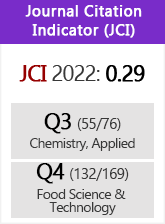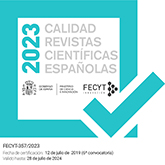Comparative study of the physicochemical properties of a vegan dressing-type mayonnaise and traditional commercial mayonnaise
DOI:
https://doi.org/10.3989/gya.0885201Keywords:
Emulsion, Mayonnaise, Physicochemical properties, VeganAbstract
The food industry has developed a vegan dressing-type mayonnaise due to new consumer demands. The aim of this study was to compare three commercial mayonnaise types with a vegan dressing, measuring their physicochemical properties. Four dressing samples were analyzed: vegan, homemade recipe, creamy, and light. The following properties were measured: water activity, color, droplet size, rheological properties, structural analysis, and oxidative stability. A high color difference was observed between vegan and the other samples due to the presence of chickpea protein. The size and distribution of droplets of the vegan sample were greater than the others. The rheological properties indicated that all samples are non-Newtonian pseudoplastic fluids. The FT-IR results indicated that the highest peak for vegan corresponded to its content in mono-unsaturated fat. Therefore, it showed the lowest oxidative stability. In conclusion, the mayonaise formulations were affected by physicochemical properties such as the content and composition of the oil, thickener and protein contents, along with processing technology.
Downloads
References
Ali MR, EL Said RM. 2020. Assessment of the potential of Arabic gum as an antimicrobial and antioxidant agent in developing vegan "egg-free" mayonnaise. J. Food Saf. 40 (2), e12771. https://doi.org/10.1111/jfs.12771
Alarcón-Moyano JK, Bustos RO, Herrera M, Matiacevich SB. 2017. Alginate edible films containing microencapsulated lemongrass oil or citral: effect of encapsulating agent and storage time on physical and antimicrobial properties. J. Food Sci. Tech. 54 (9), 2878-2889. https://doi.org/10.1007/s13197-017-2726-1 PMid:28928528 PMCid:PMC5583118
Amin MHH, Elbeltagy AE, Mustafa M, Khalil AH. 2014. Development of low fat mayonnaise containing different types and levels of hydrocolloid gum. Journal of Agroalimentary Processes and Technologies 20 (1), 54-63.
Arancibia C, Riquelme N, Zúñiga R, Matiacevich S. 2017. Comparing the effectiveness of natural and synthetic emulsifiers on oxidative and physical stability of avocado oil-based nanoemulsions. Inn. Food Sc. Em. Tech. 44, 159-166. https://doi.org/10.1016/j.ifset.2017.06.009
Chang C, Li J, Li X, Wang C, Zhou B, Su Y,Yang Y. 2017. Effect of protein microparticle and pectin on properties of light mayonnaise. LWT-Food Sc. Tech. 82, 8-14. https://doi.org/10.1016/j.lwt.2017.04.013
Chippie AL, Jamieson PR, Golt CM, Hsu CH, Martin Lo Y. 2002. Quantitative analysis of fat and moisture in mayonnaise using the Fourier Transform Infrared spectrometer. Int. J. Food Prop. 5 (3), 655-665. https://doi.org/10.1081/JFP-120015499
Codex Alimentarius Commission. 1989. Codex standard for mayonnaise (Regional European Standard) CODEXSTAN 168-1989. Codex Coordinating Committee for Europe.
Cornelia M, Siratantri T, Prawita R. 2015. The utilization of extract Durian (Durio zibethinus L.) seed gum as an emulsifier in vegan mayonnaise. Procedia Food Sc. 3, 1-18. https://doi.org/10.1016/j.profoo.2015.01.001
Daoud S, Bou-Maroun E, Dujourdy L, Waschatko G, Billecke N, Cayot P. 2019. Fast and direct analysis of oxidation levels of oil-in-water emulsions using ATR-FTIR. Food Chem. 293, 307-314. https://doi.org/10.1016/j.foodchem.2019.05.005 PMid:31151616
Depree J, Savage G. 2001. Physical and flavour stability of mayonnaise. Trends Food Sc. Tech. 12 (5), 157-163. https://doi.org/10.1016/S0924-2244(01)00079-6
Di Mattia C, Balestra F, Sacchetti G, Neri L, Mastrocola D, Pittia P. 2015. Physical and structural properties of extra-virgin olive oil based mayonnaise. LWT-Food Sc. Tech. 62 (1), 764-770. https://doi.org/10.1016/j.lwt.2014.09.065
Drozłowska E, Łopusiewicz Ł, Mężyńska M, Bartkowiak A. 2020. The effect of native and denaturated flaxseed meal extract on physiochemical properties of low fat mayonnaises. J. Food Meas. Charact. 14 (2), 1135-1145. https://doi.org/10.1007/s11694-019-00363-6
Fenoglio D, Soto-Madrid D, Alarcón-Moyano JK, Ferrario M, Guerrero S, Matiacevich S. 2020. Active food additive based on encapsulated yerba mate (Ilex paraguariensis) extract: effect of drying methods on the oxidative stability of a real food matrix (mayonnaise). J. Food Sc. Tech. 1-11. https://doi.org/10.1007/s13197-020-04669-y PMid:33746284
Jiménez-Colmenero F, Cofrades S, Herrero AM, Solas MT, Ruiz-Capillas C. 2013. Konjac gel for use as a potential fat analog for healthier meat product development: Effect of chilled and frozen storage. Food Hydrocol. 30 (1), 351-357. https://doi.org/10.1016/j.foodhyd.2012.06.015
Juszczak L, Fortuna T, Kośla A. 2003. Sensory and rheological properties of Polish commercial mayonnaise. Food/Nahrung. 47 (4), 232-235. https://doi.org/10.1002/food.200390054 PMid:13678259
Laca A, Sáenz MC, Paredes B, Díaz M. 2010. Rheological properties, stability and sensory evaluation of low-cholesterol mayonnaises prepared using egg yolk granules as emulsifying agent. J. Food Eng. 97 (2), 243-252. https://doi.org/10.1016/j.jfoodeng.2009.10.017
Li J, Wang Y, Jin W, Zhou B, Li B. 2014. Application of micronized konjac gel for fat analog in mayonnaise. Food Hydrocol. 35, 375-382. https://doi.org/10.1016/j.foodhyd.2013.06.010
Liu H, Xu XM, Guo SD. 2007. Rheological, texture, and sensory properties of low-fat mayonnaise with different fat mimetics. LWT-Food Sc. Tech. 40 (6), 946-954. https://doi.org/10.1016/j.lwt.2006.11.007
Ma L, Barbosa-Cánovas GV. 1995. Rheological characterization of mayonnaise. Part II: Flow and viscoelastic properties at different oil and xanthan gum concentrations. J. Food Eng. 25 (3), 409-425. https://doi.org/10.1016/0260-8774(94)00010-7
Matiacevich S, Acevedo N, López D. 2015. Characterization of edible active coating based on alginate-thyme oil-propionic acid for the preservation of fresh chicken breast fillets. J. Food Proc. Pres. 39 (6), 2792-2801. https://doi.org/10.1111/jfpp.12530
McClements DJ. 2012. Nanoemulsions versus microemulsions: terminology, differences, and similarities. Soft Matter 8 (6), 1719-1729. https://doi.org/10.1039/C2SM06903B
Miguel GA, Jacobsen C, Prieto C, Kempen PJ, Lagaron JM, Chronakis IS, García-Moreno P J. 2019. Oxidative stability and physical properties of mayonnaise fortified with zein electrosprayed capsules loaded with fish oil. J. Food Eng. 263, 348-358. https://doi.org/10.1016/j.jfoodeng.2019.07.019
Mirzanajafi-Zanjani M, Yousefi M, Ehsani A. 2019. Challenges and approaches for production of a healthy and functional mayonnaise sauce. Food Sc. Nutr. 7 (8), 2471-2484. https://doi.org/10.1002/fsn3.1132 PMid:31428335 PMCid:PMC6694423
Mun S, Kim YL, Kang CG, Park KH, Shim JY, Kim YR. 2009. Development of reduced-fat mayonnaise using 4αGTase-modified rice starch and xanthan gum. Int. J. Biol. Macromol. 44 (5), 400-407. https://doi.org/10.1016/j.ijbiomac.2009.02.008 PMid:19428473
Muñoz J, Alfaro M, Zapata I. 2007. Avances en la formulación de emulsiones. Grasas Aceites 58 (1), 64-73. https://doi.org/10.3989/gya.2007.v58.i1.10
Noon J, Mills TB, Norton IT. 2020. The use of natural antioxidants to combat lipid oxidation in O/W emulsions. J. Food Eng. 281, 110006. https://doi.org/10.1016/j.jfoodeng.2020.110006
Park JJ, Olawuyi IF, Lee WY. 2020. Characteristics of low-fat mayonnaise using different modified arrowroot starches as fat replacers. Int. J. Biol. Macromol. 153, 215-223. https://doi.org/10.1016/j.ijbiomac.2020.02.331 PMid:32135256
Peressini D, Sensidoni A, De Cindio B. 1998. Rheological characterization of traditional and light mayonnaises. J. Food Eng. 35 (4), 409-417. https://doi.org/10.1016/S0260-8774(98)00032-6
Primacella M, Wang T, Acevedo NC. 2019. Characterization of mayonnaise properties prepared using frozen-thawed egg yolk treated with hydrolyzed egg yolk proteins as anti-gelator. Food Hydrocol. 96, 529-536. https://doi.org/10.1016/j.foodhyd.2019.06.008
Raikos V, Hayes H, Ni H. 2020. Aquafaba from commercially canned chickpeas as potential egg replacer for the development of vegan mayonnaise: recipe optimisation and storage stability. Int. J. Food Sc. Tech. 55 (5), 1935-1942. https://doi.org/10.1111/ijfs.14427
Rohman A, Che Man YB, Hashim P, Ismail A. 2011. FTIR spectroscopy combined with chemometrics for analysis of lard adulteration in some vegetable oils. Cyta-J. Food. 9 (2), 96-101. https://doi.org/10.1080/19476331003774639
Roman GC, Jackson RE, Gadhia R, Roman AN; Reis J. 2019. Mediterranean diet: The role of long-chain ω-3 fatty acids in fish; polyphenols in fruits, vegetables, cereals, coffee, tea, cacao, and wine; probiotics and vitamins in the prevention of stroke, age-related cognitive decline, and Alzheimer disease. Revue Neurol. 175, 724-741. https://doi.org/10.1016/j.neurol.2019.08.005 PMid:31521398
Shen R, Luo S, Dong J. 2011. Application of oat dextrin for fat substitute in mayonnaise. Food Chem. 126 (1), 65-71. https://doi.org/10.1016/j.foodchem.2010.10.072
Schultz S, Wagner G, Urban K, Ulrich J. 2004. High-pressure homogenization as a process for emulsion formation. Chem. Eng. Tech. 27 (4), 361-368. https://doi.org/10.1002/ceat.200406111
Štern P, Valentová H, Pokorný J. 2001. Rheological properties and sensory texture of mayonnaise. Europ. J. Lipid Sc. Tech. 103 (1), 23-28. https://doi.org/10.1002/1438-9312(200101)103:1<23::AID-EJLT23>3.0.CO;2-P
Sun C, Liu R, Liang B, Wu T, Sui W, Zhang M. 2018. Microparticulated whey protein-pectin complex: A texture-controllable gel for low-fat mayonnaise. Food Res. Int. 108, 151-160. https://doi.org/10.1016/j.foodres.2018.01.036 PMid:29735044
Worrasinchai S, Suphantharika M, Pinjai S, Jamnong P. 2006. β-Glucan prepared from spent brewer's yeast as a fat replacer in mayonnaise. Food Hydrocol. 20 (1), 68-78. https://doi.org/10.1016/j.foodhyd.2005.03.005
Yang Y, Ming J, Yu N. 2012. Color image quality assessment based on CIEDE2000. Adv. Multimedia 2012, 1-6. https://doi.org/10.1155/2012/273723
Zia-Ud-Din, Xiong H, Fei P. 2017. Physical and chemical modification of starches: A review. Crit. Rev. Food Sc. Nutr. 57 (12), 2691-2705 https://doi.org/10.1080/10408398.2015.1087379 PMid:26529587
Published
How to Cite
Issue
Section
License
Copyright (c) 2021 Consejo Superior de Investigaciones Científicas (CSIC)

This work is licensed under a Creative Commons Attribution 4.0 International License.
© CSIC. Manuscripts published in both the printed and online versions of this Journal are the property of Consejo Superior de Investigaciones Científicas, and quoting this source is a requirement for any partial or full reproduction.All contents of this electronic edition, except where otherwise noted, are distributed under a “Creative Commons Attribution 4.0 International” (CC BY 4.0) License. You may read here the basic information and the legal text of the license. The indication of the CC BY 4.0 License must be expressly stated in this way when necessary.
Self-archiving in repositories, personal webpages or similar, of any version other than the published by the Editor, is not allowed.
















